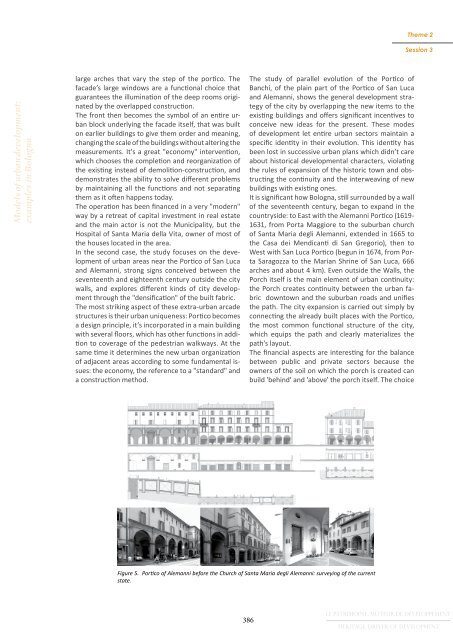PARTIE 2 - Icomos
PARTIE 2 - Icomos
PARTIE 2 - Icomos
You also want an ePaper? Increase the reach of your titles
YUMPU automatically turns print PDFs into web optimized ePapers that Google loves.
Theme 2<br />
Session 3<br />
Models of urban development:<br />
examples in Bologna<br />
large arches that vary the step of the portico. The<br />
facade’s large windows are a functional choice that<br />
guarantees the illumination of the deep rooms originated<br />
by the overlapped construction.<br />
The front then becomes the symbol of an entire urban<br />
block underlying the facade itself, that was built<br />
on earlier buildings to give them order and meaning,<br />
changing the scale of the buildings without altering the<br />
measurements. It's a great "economy" intervention,<br />
which chooses the completion and reorganization of<br />
the existing instead of demolition-construction, and<br />
demonstrates the ability to solve different problems<br />
by maintaining all the functions and not separating<br />
them as it often happens today.<br />
The operation has been financed in a very "modern"<br />
way by a retreat of capital investment in real estate<br />
and the main actor is not the Municipality, but the<br />
Hospital of Santa Maria della Vita, owner of most of<br />
the houses located in the area.<br />
In the second case, the study focuses on the development<br />
of urban areas near the Portico of San Luca<br />
and Alemanni, strong signs conceived between the<br />
seventeenth and eighteenth century outside the city<br />
walls, and explores different kinds of city development<br />
through the "densification" of the built fabric.<br />
The most striking aspect of these extra-urban arcade<br />
structures is their urban uniqueness: Portico becomes<br />
a design principle, it’s incorporated in a main building<br />
with several floors, which has other functions in addition<br />
to coverage of the pedestrian walkways. At the<br />
same time it determines the new urban organization<br />
of adjacent areas according to some fundamental issues:<br />
the economy, the reference to a "standard" and<br />
a construction method.<br />
The study of parallel evolution of the Portico of<br />
Banchi, of the plain part of the Portico of San Luca<br />
and Alemanni, shows the general development strategy<br />
of the city by overlapping the new items to the<br />
existing buildings and offers significant incentives to<br />
conceive new ideas for the present. These modes<br />
of development let entire urban sectors maintain a<br />
specific identity in their evolution. This identity has<br />
been lost in successive urban plans which didn’t care<br />
about historical developmental characters, violating<br />
the rules of expansion of the historic town and obstructing<br />
the continuity and the interweaving of new<br />
buildings with existing ones.<br />
It is significant how Bologna, still surrounded by a wall<br />
of the seventeenth century, began to expand in the<br />
countryside: to East with the Alemanni Portico (1619-<br />
1631, from Porta Maggiore to the suburban church<br />
of Santa Maria degli Alemanni, extended in 1665 to<br />
the Casa dei Mendicanti di San Gregorio), then to<br />
West with San Luca Portico (begun in 1674, from Porta<br />
Saragozza to the Marian Shrine of San Luca, 666<br />
arches and about 4 km). Even outside the Walls, the<br />
Porch itself is the main element of urban continuity:<br />
the Porch creates continuity between the urban fabric<br />
downtown and the suburban roads and unifies<br />
the path. The city expansion is carried out simply by<br />
connecting the already built places with the Portico,<br />
the most common functional structure of the city,<br />
which equips the path and clearly materializes the<br />
path’s layout.<br />
The financial aspects are interesting for the balance<br />
between public and private sectors because the<br />
owners of the soil on which the porch is created can<br />
build 'behind' and 'above' the porch itself. The choice<br />
Figure 5. Portico of Alemanni before the Church of Santa Maria degli Alemanni: surveying of the current<br />
state.<br />
386<br />
LE PATRIMOINE, MOTEUR DE DÉVELOPPEMENT<br />
HERITAGE, DRIVER OF DEVELOPMENT

















